HME711 Assignment 1: Ethicolegal Analysis of Resource Allocation
VerifiedAdded on 2023/06/03
|13
|3555
|87
Report
AI Summary
This report provides a comprehensive analysis of the ethicolegal issues surrounding resource allocation in emergency care units. It begins with an introduction to the ethical considerations that guide decision-making in resource-scarce environments, focusing on the principles of utilitarianism, virtue ethics, and deontology. The report delves into the complexities of triage, distributive justice, and patient autonomy, highlighting the importance of balancing societal benefit with individual rights. It explores the legal considerations, including patient rights and potential legal actions arising from resource allocation decisions. The report also addresses principles such as beneficence and non-maleficence. The report emphasizes the need for a balanced approach that considers both ethical and legal frameworks to ensure equitable and effective healthcare delivery. This assignment is contributed by a student to be published on the website Desklib, a platform which provides all the necessary AI based study tools for students.
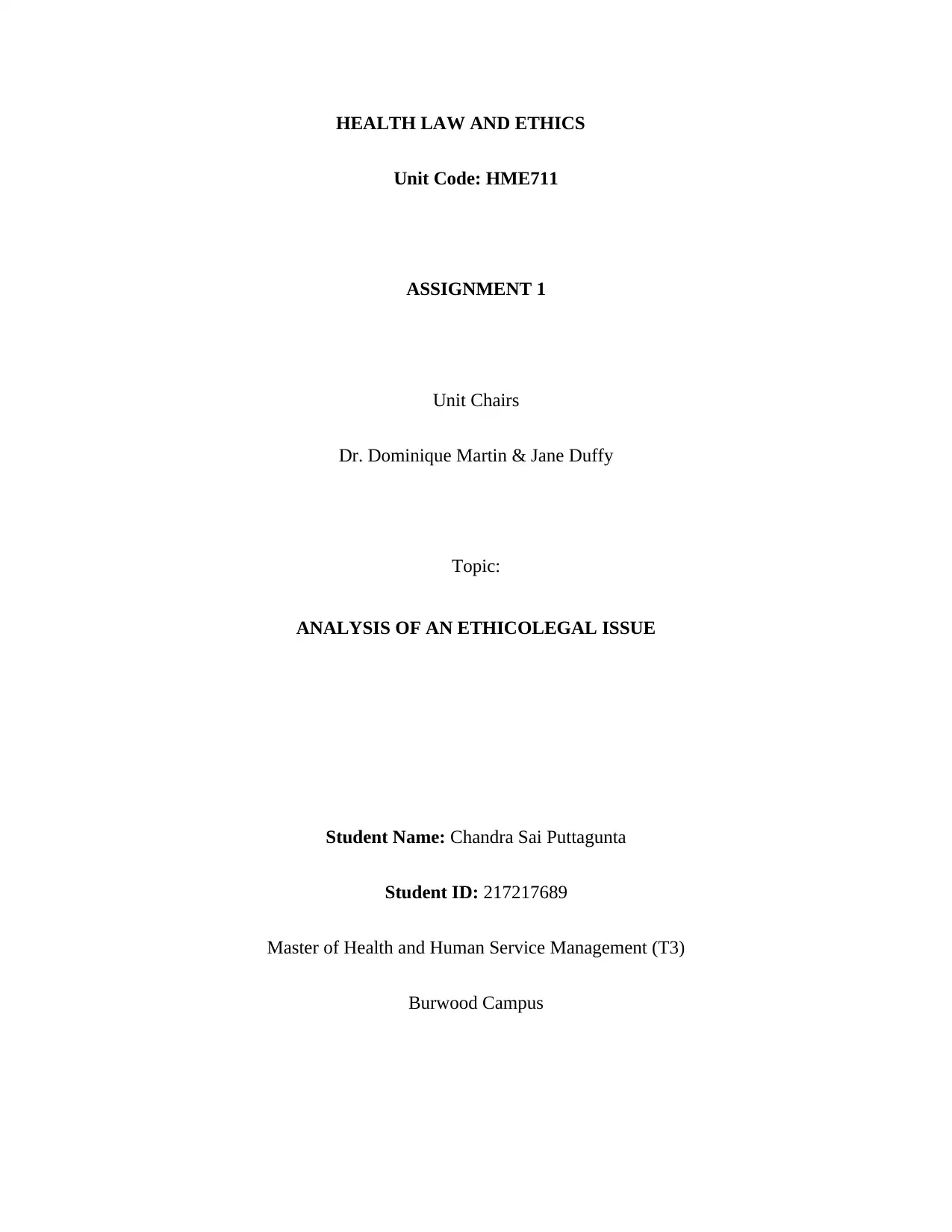
HEALTH LAW AND ETHICS
Unit Code: HME711
ASSIGNMENT 1
Unit Chairs
Dr. Dominique Martin & Jane Duffy
Topic:
ANALYSIS OF AN ETHICOLEGAL ISSUE
Student Name: Chandra Sai Puttagunta
Student ID: 217217689
Master of Health and Human Service Management (T3)
Burwood Campus
Unit Code: HME711
ASSIGNMENT 1
Unit Chairs
Dr. Dominique Martin & Jane Duffy
Topic:
ANALYSIS OF AN ETHICOLEGAL ISSUE
Student Name: Chandra Sai Puttagunta
Student ID: 217217689
Master of Health and Human Service Management (T3)
Burwood Campus
Paraphrase This Document
Need a fresh take? Get an instant paraphrase of this document with our AI Paraphraser
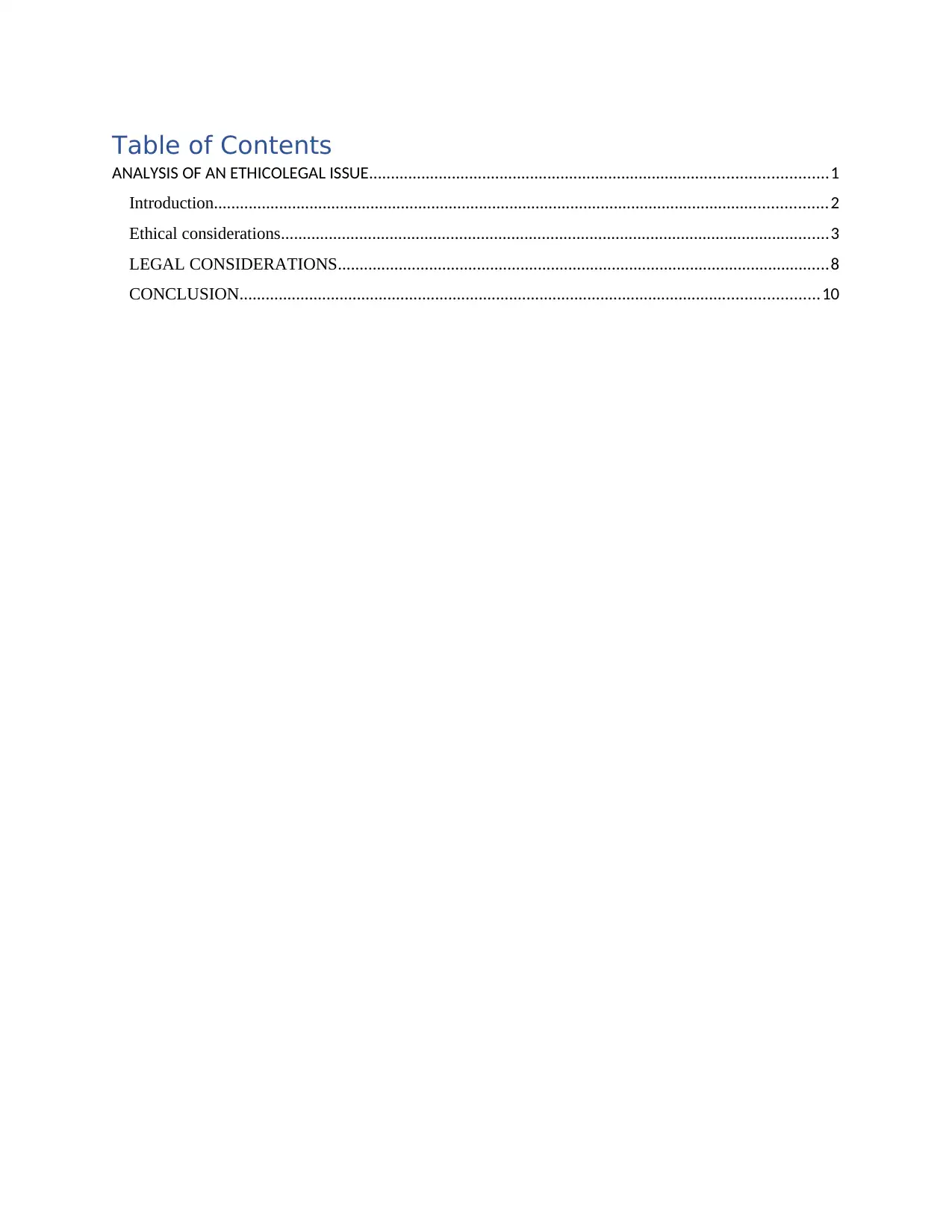
Table of Contents
ANALYSIS OF AN ETHICOLEGAL ISSUE.........................................................................................................1
Introduction.............................................................................................................................................2
Ethical considerations..............................................................................................................................3
LEGAL CONSIDERATIONS.................................................................................................................8
CONCLUSION.....................................................................................................................................10
ANALYSIS OF AN ETHICOLEGAL ISSUE.........................................................................................................1
Introduction.............................................................................................................................................2
Ethical considerations..............................................................................................................................3
LEGAL CONSIDERATIONS.................................................................................................................8
CONCLUSION.....................................................................................................................................10
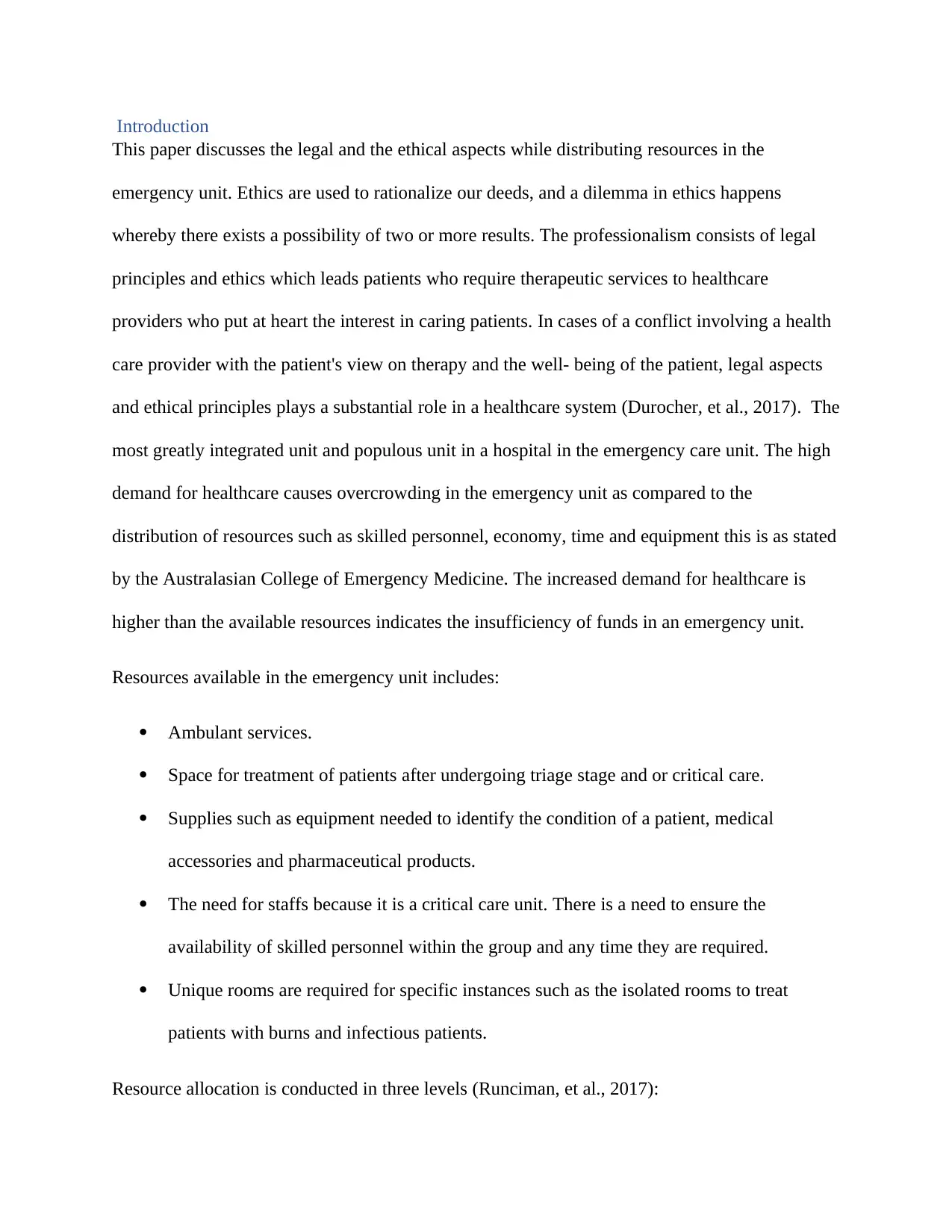
Introduction
This paper discusses the legal and the ethical aspects while distributing resources in the
emergency unit. Ethics are used to rationalize our deeds, and a dilemma in ethics happens
whereby there exists a possibility of two or more results. The professionalism consists of legal
principles and ethics which leads patients who require therapeutic services to healthcare
providers who put at heart the interest in caring patients. In cases of a conflict involving a health
care provider with the patient's view on therapy and the well- being of the patient, legal aspects
and ethical principles plays a substantial role in a healthcare system (Durocher, et al., 2017). The
most greatly integrated unit and populous unit in a hospital in the emergency care unit. The high
demand for healthcare causes overcrowding in the emergency unit as compared to the
distribution of resources such as skilled personnel, economy, time and equipment this is as stated
by the Australasian College of Emergency Medicine. The increased demand for healthcare is
higher than the available resources indicates the insufficiency of funds in an emergency unit.
Resources available in the emergency unit includes:
Ambulant services.
Space for treatment of patients after undergoing triage stage and or critical care.
Supplies such as equipment needed to identify the condition of a patient, medical
accessories and pharmaceutical products.
The need for staffs because it is a critical care unit. There is a need to ensure the
availability of skilled personnel within the group and any time they are required.
Unique rooms are required for specific instances such as the isolated rooms to treat
patients with burns and infectious patients.
Resource allocation is conducted in three levels (Runciman, et al., 2017):
This paper discusses the legal and the ethical aspects while distributing resources in the
emergency unit. Ethics are used to rationalize our deeds, and a dilemma in ethics happens
whereby there exists a possibility of two or more results. The professionalism consists of legal
principles and ethics which leads patients who require therapeutic services to healthcare
providers who put at heart the interest in caring patients. In cases of a conflict involving a health
care provider with the patient's view on therapy and the well- being of the patient, legal aspects
and ethical principles plays a substantial role in a healthcare system (Durocher, et al., 2017). The
most greatly integrated unit and populous unit in a hospital in the emergency care unit. The high
demand for healthcare causes overcrowding in the emergency unit as compared to the
distribution of resources such as skilled personnel, economy, time and equipment this is as stated
by the Australasian College of Emergency Medicine. The increased demand for healthcare is
higher than the available resources indicates the insufficiency of funds in an emergency unit.
Resources available in the emergency unit includes:
Ambulant services.
Space for treatment of patients after undergoing triage stage and or critical care.
Supplies such as equipment needed to identify the condition of a patient, medical
accessories and pharmaceutical products.
The need for staffs because it is a critical care unit. There is a need to ensure the
availability of skilled personnel within the group and any time they are required.
Unique rooms are required for specific instances such as the isolated rooms to treat
patients with burns and infectious patients.
Resource allocation is conducted in three levels (Runciman, et al., 2017):
⊘ This is a preview!⊘
Do you want full access?
Subscribe today to unlock all pages.

Trusted by 1+ million students worldwide
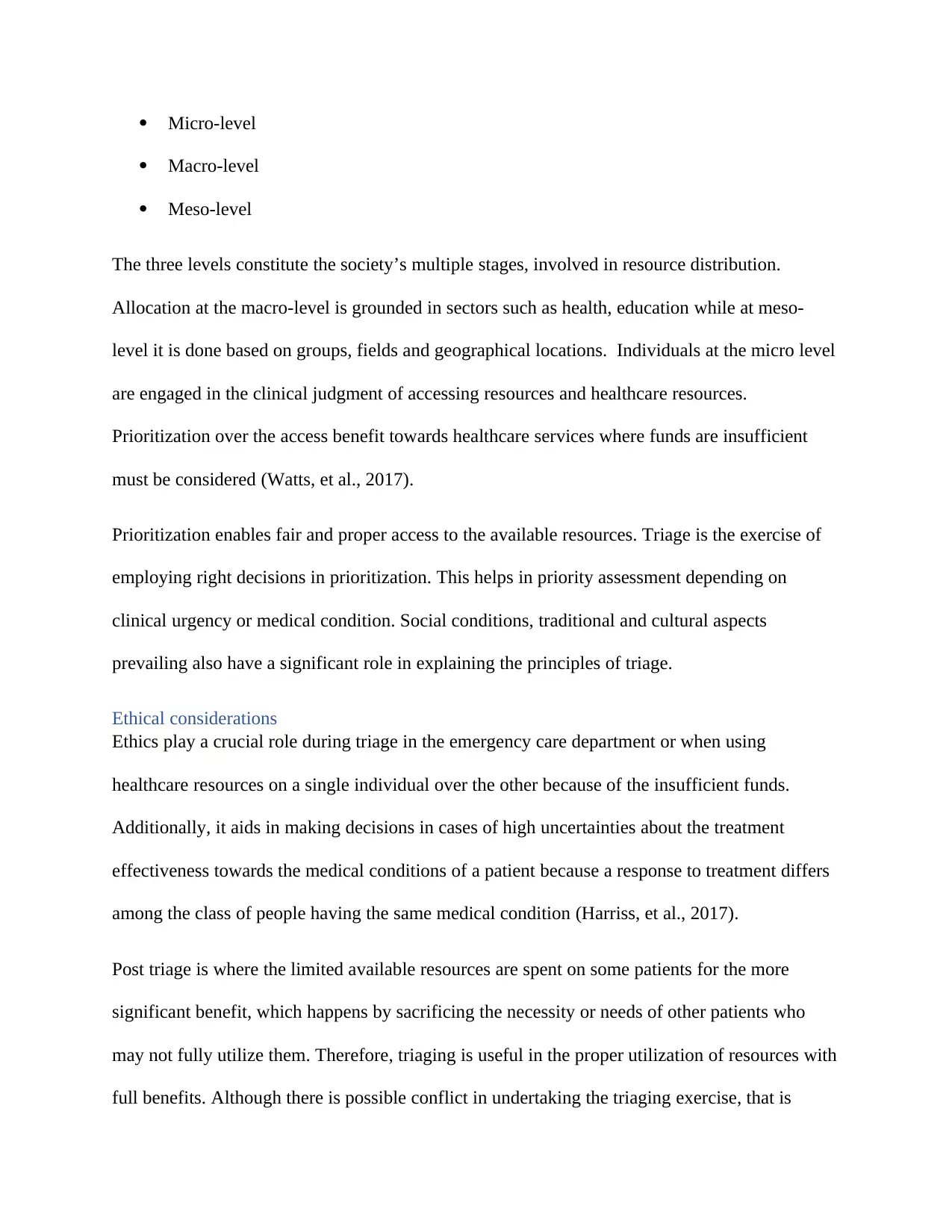
Micro-level
Macro-level
Meso-level
The three levels constitute the society’s multiple stages, involved in resource distribution.
Allocation at the macro-level is grounded in sectors such as health, education while at meso-
level it is done based on groups, fields and geographical locations. Individuals at the micro level
are engaged in the clinical judgment of accessing resources and healthcare resources.
Prioritization over the access benefit towards healthcare services where funds are insufficient
must be considered (Watts, et al., 2017).
Prioritization enables fair and proper access to the available resources. Triage is the exercise of
employing right decisions in prioritization. This helps in priority assessment depending on
clinical urgency or medical condition. Social conditions, traditional and cultural aspects
prevailing also have a significant role in explaining the principles of triage.
Ethical considerations
Ethics play a crucial role during triage in the emergency care department or when using
healthcare resources on a single individual over the other because of the insufficient funds.
Additionally, it aids in making decisions in cases of high uncertainties about the treatment
effectiveness towards the medical conditions of a patient because a response to treatment differs
among the class of people having the same medical condition (Harriss, et al., 2017).
Post triage is where the limited available resources are spent on some patients for the more
significant benefit, which happens by sacrificing the necessity or needs of other patients who
may not fully utilize them. Therefore, triaging is useful in the proper utilization of resources with
full benefits. Although there is possible conflict in undertaking the triaging exercise, that is
Macro-level
Meso-level
The three levels constitute the society’s multiple stages, involved in resource distribution.
Allocation at the macro-level is grounded in sectors such as health, education while at meso-
level it is done based on groups, fields and geographical locations. Individuals at the micro level
are engaged in the clinical judgment of accessing resources and healthcare resources.
Prioritization over the access benefit towards healthcare services where funds are insufficient
must be considered (Watts, et al., 2017).
Prioritization enables fair and proper access to the available resources. Triage is the exercise of
employing right decisions in prioritization. This helps in priority assessment depending on
clinical urgency or medical condition. Social conditions, traditional and cultural aspects
prevailing also have a significant role in explaining the principles of triage.
Ethical considerations
Ethics play a crucial role during triage in the emergency care department or when using
healthcare resources on a single individual over the other because of the insufficient funds.
Additionally, it aids in making decisions in cases of high uncertainties about the treatment
effectiveness towards the medical conditions of a patient because a response to treatment differs
among the class of people having the same medical condition (Harriss, et al., 2017).
Post triage is where the limited available resources are spent on some patients for the more
significant benefit, which happens by sacrificing the necessity or needs of other patients who
may not fully utilize them. Therefore, triaging is useful in the proper utilization of resources with
full benefits. Although there is possible conflict in undertaking the triaging exercise, that is
Paraphrase This Document
Need a fresh take? Get an instant paraphrase of this document with our AI Paraphraser
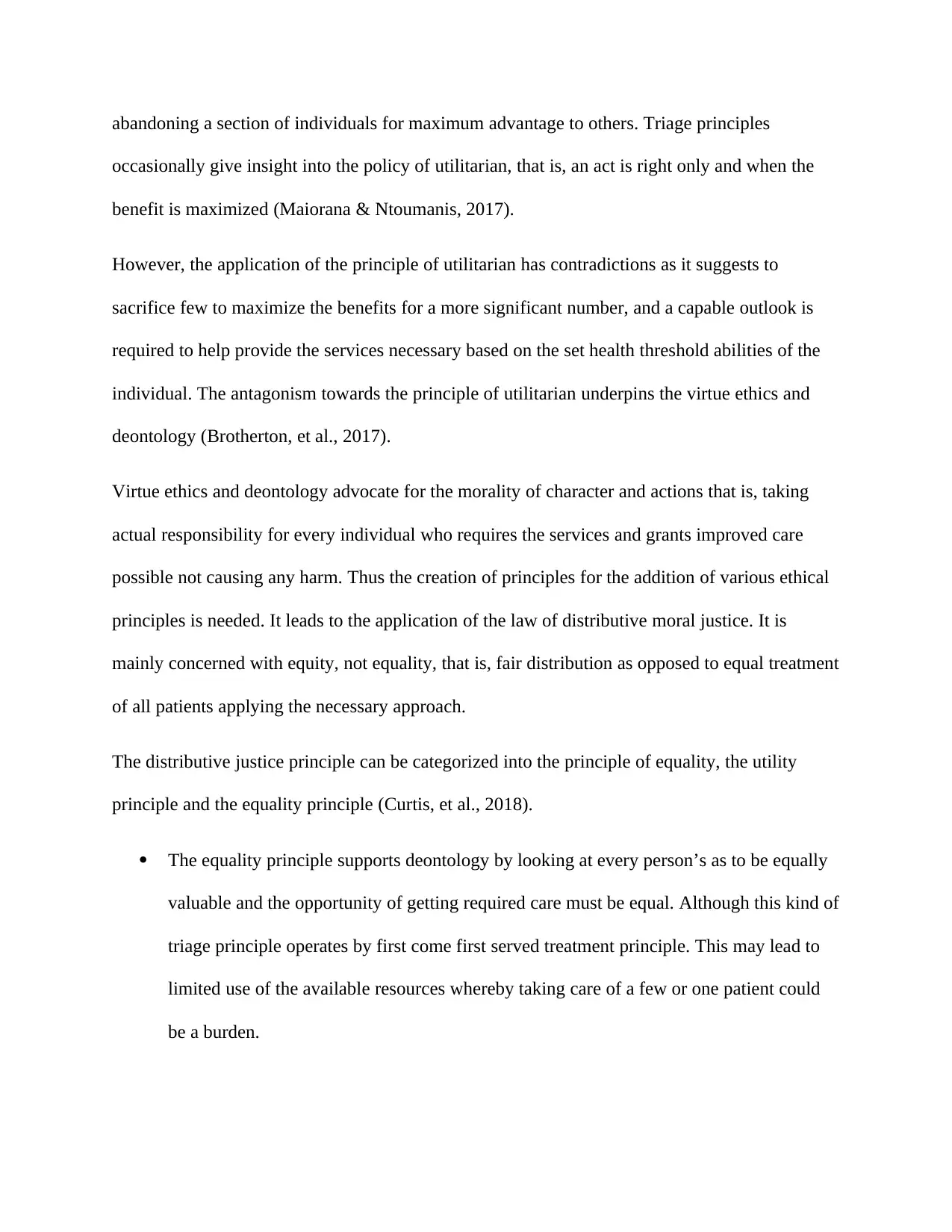
abandoning a section of individuals for maximum advantage to others. Triage principles
occasionally give insight into the policy of utilitarian, that is, an act is right only and when the
benefit is maximized (Maiorana & Ntoumanis, 2017).
However, the application of the principle of utilitarian has contradictions as it suggests to
sacrifice few to maximize the benefits for a more significant number, and a capable outlook is
required to help provide the services necessary based on the set health threshold abilities of the
individual. The antagonism towards the principle of utilitarian underpins the virtue ethics and
deontology (Brotherton, et al., 2017).
Virtue ethics and deontology advocate for the morality of character and actions that is, taking
actual responsibility for every individual who requires the services and grants improved care
possible not causing any harm. Thus the creation of principles for the addition of various ethical
principles is needed. It leads to the application of the law of distributive moral justice. It is
mainly concerned with equity, not equality, that is, fair distribution as opposed to equal treatment
of all patients applying the necessary approach.
The distributive justice principle can be categorized into the principle of equality, the utility
principle and the equality principle (Curtis, et al., 2018).
The equality principle supports deontology by looking at every person’s as to be equally
valuable and the opportunity of getting required care must be equal. Although this kind of
triage principle operates by first come first served treatment principle. This may lead to
limited use of the available resources whereby taking care of a few or one patient could
be a burden.
occasionally give insight into the policy of utilitarian, that is, an act is right only and when the
benefit is maximized (Maiorana & Ntoumanis, 2017).
However, the application of the principle of utilitarian has contradictions as it suggests to
sacrifice few to maximize the benefits for a more significant number, and a capable outlook is
required to help provide the services necessary based on the set health threshold abilities of the
individual. The antagonism towards the principle of utilitarian underpins the virtue ethics and
deontology (Brotherton, et al., 2017).
Virtue ethics and deontology advocate for the morality of character and actions that is, taking
actual responsibility for every individual who requires the services and grants improved care
possible not causing any harm. Thus the creation of principles for the addition of various ethical
principles is needed. It leads to the application of the law of distributive moral justice. It is
mainly concerned with equity, not equality, that is, fair distribution as opposed to equal treatment
of all patients applying the necessary approach.
The distributive justice principle can be categorized into the principle of equality, the utility
principle and the equality principle (Curtis, et al., 2018).
The equality principle supports deontology by looking at every person’s as to be equally
valuable and the opportunity of getting required care must be equal. Although this kind of
triage principle operates by first come first served treatment principle. This may lead to
limited use of the available resources whereby taking care of a few or one patient could
be a burden.
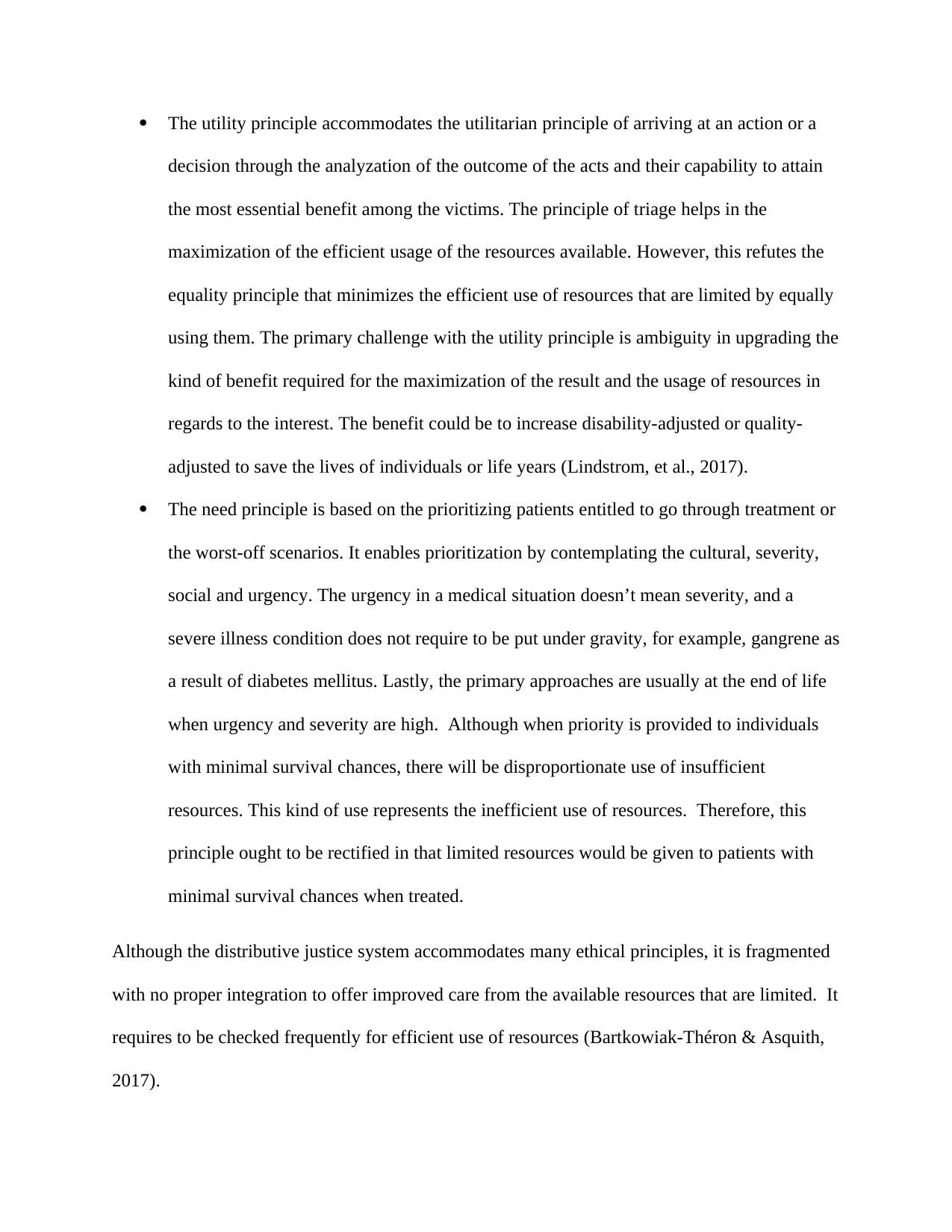
The utility principle accommodates the utilitarian principle of arriving at an action or a
decision through the analyzation of the outcome of the acts and their capability to attain
the most essential benefit among the victims. The principle of triage helps in the
maximization of the efficient usage of the resources available. However, this refutes the
equality principle that minimizes the efficient use of resources that are limited by equally
using them. The primary challenge with the utility principle is ambiguity in upgrading the
kind of benefit required for the maximization of the result and the usage of resources in
regards to the interest. The benefit could be to increase disability-adjusted or quality-
adjusted to save the lives of individuals or life years (Lindstrom, et al., 2017).
The need principle is based on the prioritizing patients entitled to go through treatment or
the worst-off scenarios. It enables prioritization by contemplating the cultural, severity,
social and urgency. The urgency in a medical situation doesn’t mean severity, and a
severe illness condition does not require to be put under gravity, for example, gangrene as
a result of diabetes mellitus. Lastly, the primary approaches are usually at the end of life
when urgency and severity are high. Although when priority is provided to individuals
with minimal survival chances, there will be disproportionate use of insufficient
resources. This kind of use represents the inefficient use of resources. Therefore, this
principle ought to be rectified in that limited resources would be given to patients with
minimal survival chances when treated.
Although the distributive justice system accommodates many ethical principles, it is fragmented
with no proper integration to offer improved care from the available resources that are limited. It
requires to be checked frequently for efficient use of resources (Bartkowiak-Théron & Asquith,
2017).
decision through the analyzation of the outcome of the acts and their capability to attain
the most essential benefit among the victims. The principle of triage helps in the
maximization of the efficient usage of the resources available. However, this refutes the
equality principle that minimizes the efficient use of resources that are limited by equally
using them. The primary challenge with the utility principle is ambiguity in upgrading the
kind of benefit required for the maximization of the result and the usage of resources in
regards to the interest. The benefit could be to increase disability-adjusted or quality-
adjusted to save the lives of individuals or life years (Lindstrom, et al., 2017).
The need principle is based on the prioritizing patients entitled to go through treatment or
the worst-off scenarios. It enables prioritization by contemplating the cultural, severity,
social and urgency. The urgency in a medical situation doesn’t mean severity, and a
severe illness condition does not require to be put under gravity, for example, gangrene as
a result of diabetes mellitus. Lastly, the primary approaches are usually at the end of life
when urgency and severity are high. Although when priority is provided to individuals
with minimal survival chances, there will be disproportionate use of insufficient
resources. This kind of use represents the inefficient use of resources. Therefore, this
principle ought to be rectified in that limited resources would be given to patients with
minimal survival chances when treated.
Although the distributive justice system accommodates many ethical principles, it is fragmented
with no proper integration to offer improved care from the available resources that are limited. It
requires to be checked frequently for efficient use of resources (Bartkowiak-Théron & Asquith,
2017).
⊘ This is a preview!⊘
Do you want full access?
Subscribe today to unlock all pages.

Trusted by 1+ million students worldwide
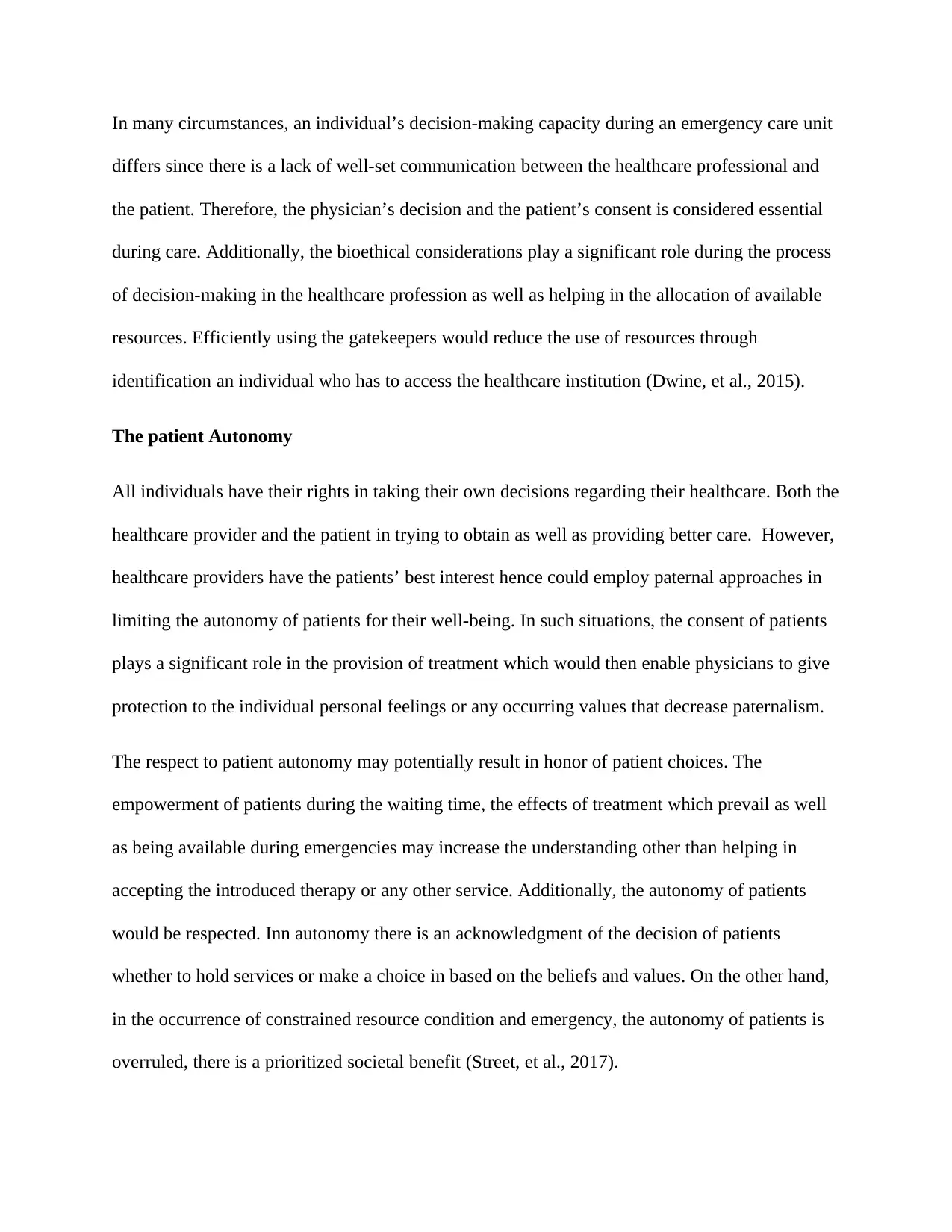
In many circumstances, an individual’s decision-making capacity during an emergency care unit
differs since there is a lack of well-set communication between the healthcare professional and
the patient. Therefore, the physician’s decision and the patient’s consent is considered essential
during care. Additionally, the bioethical considerations play a significant role during the process
of decision-making in the healthcare profession as well as helping in the allocation of available
resources. Efficiently using the gatekeepers would reduce the use of resources through
identification an individual who has to access the healthcare institution (Dwine, et al., 2015).
The patient Autonomy
All individuals have their rights in taking their own decisions regarding their healthcare. Both the
healthcare provider and the patient in trying to obtain as well as providing better care. However,
healthcare providers have the patients’ best interest hence could employ paternal approaches in
limiting the autonomy of patients for their well-being. In such situations, the consent of patients
plays a significant role in the provision of treatment which would then enable physicians to give
protection to the individual personal feelings or any occurring values that decrease paternalism.
The respect to patient autonomy may potentially result in honor of patient choices. The
empowerment of patients during the waiting time, the effects of treatment which prevail as well
as being available during emergencies may increase the understanding other than helping in
accepting the introduced therapy or any other service. Additionally, the autonomy of patients
would be respected. Inn autonomy there is an acknowledgment of the decision of patients
whether to hold services or make a choice in based on the beliefs and values. On the other hand,
in the occurrence of constrained resource condition and emergency, the autonomy of patients is
overruled, there is a prioritized societal benefit (Street, et al., 2017).
differs since there is a lack of well-set communication between the healthcare professional and
the patient. Therefore, the physician’s decision and the patient’s consent is considered essential
during care. Additionally, the bioethical considerations play a significant role during the process
of decision-making in the healthcare profession as well as helping in the allocation of available
resources. Efficiently using the gatekeepers would reduce the use of resources through
identification an individual who has to access the healthcare institution (Dwine, et al., 2015).
The patient Autonomy
All individuals have their rights in taking their own decisions regarding their healthcare. Both the
healthcare provider and the patient in trying to obtain as well as providing better care. However,
healthcare providers have the patients’ best interest hence could employ paternal approaches in
limiting the autonomy of patients for their well-being. In such situations, the consent of patients
plays a significant role in the provision of treatment which would then enable physicians to give
protection to the individual personal feelings or any occurring values that decrease paternalism.
The respect to patient autonomy may potentially result in honor of patient choices. The
empowerment of patients during the waiting time, the effects of treatment which prevail as well
as being available during emergencies may increase the understanding other than helping in
accepting the introduced therapy or any other service. Additionally, the autonomy of patients
would be respected. Inn autonomy there is an acknowledgment of the decision of patients
whether to hold services or make a choice in based on the beliefs and values. On the other hand,
in the occurrence of constrained resource condition and emergency, the autonomy of patients is
overruled, there is a prioritized societal benefit (Street, et al., 2017).
Paraphrase This Document
Need a fresh take? Get an instant paraphrase of this document with our AI Paraphraser
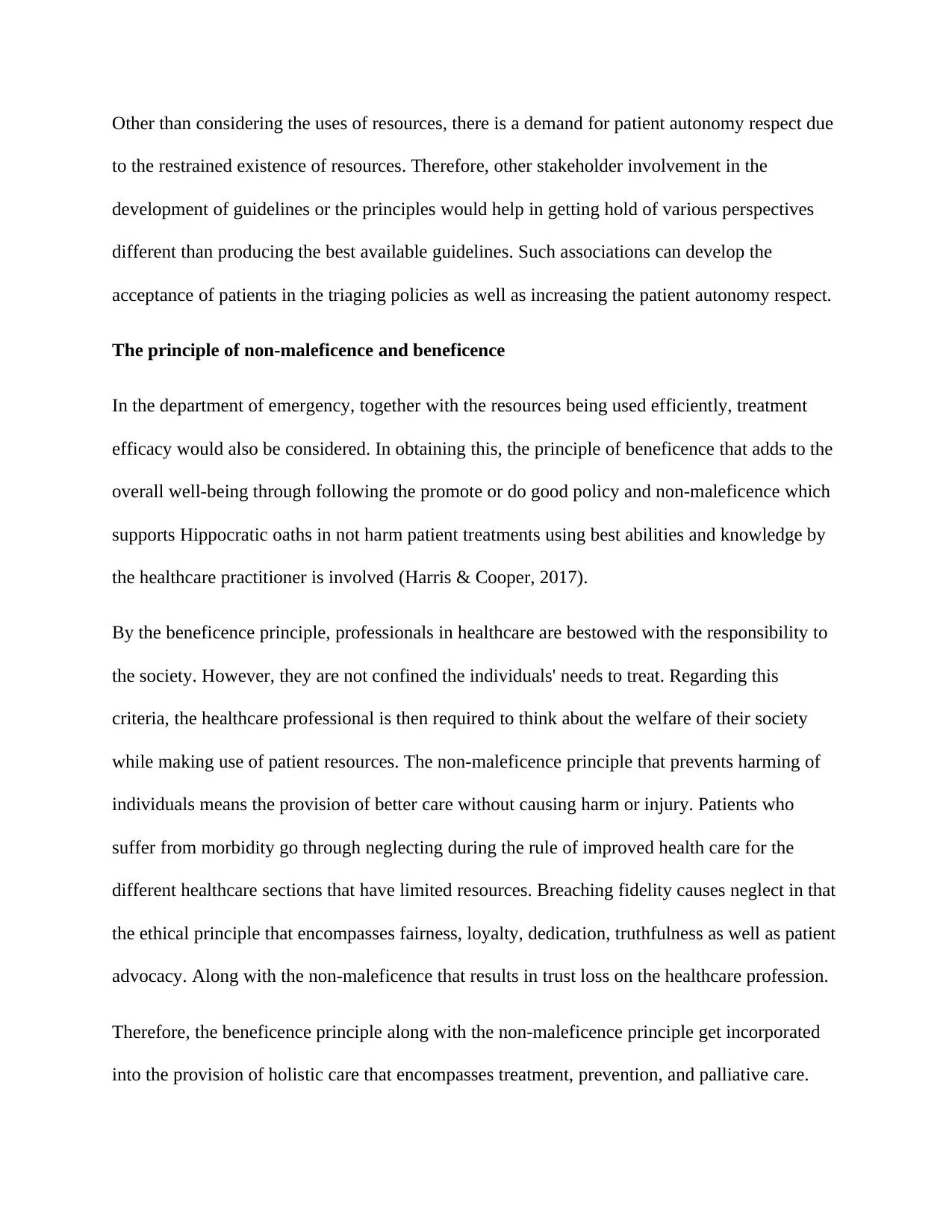
Other than considering the uses of resources, there is a demand for patient autonomy respect due
to the restrained existence of resources. Therefore, other stakeholder involvement in the
development of guidelines or the principles would help in getting hold of various perspectives
different than producing the best available guidelines. Such associations can develop the
acceptance of patients in the triaging policies as well as increasing the patient autonomy respect.
The principle of non-maleficence and beneficence
In the department of emergency, together with the resources being used efficiently, treatment
efficacy would also be considered. In obtaining this, the principle of beneficence that adds to the
overall well-being through following the promote or do good policy and non-maleficence which
supports Hippocratic oaths in not harm patient treatments using best abilities and knowledge by
the healthcare practitioner is involved (Harris & Cooper, 2017).
By the beneficence principle, professionals in healthcare are bestowed with the responsibility to
the society. However, they are not confined the individuals' needs to treat. Regarding this
criteria, the healthcare professional is then required to think about the welfare of their society
while making use of patient resources. The non-maleficence principle that prevents harming of
individuals means the provision of better care without causing harm or injury. Patients who
suffer from morbidity go through neglecting during the rule of improved health care for the
different healthcare sections that have limited resources. Breaching fidelity causes neglect in that
the ethical principle that encompasses fairness, loyalty, dedication, truthfulness as well as patient
advocacy. Along with the non-maleficence that results in trust loss on the healthcare profession.
Therefore, the beneficence principle along with the non-maleficence principle get incorporated
into the provision of holistic care that encompasses treatment, prevention, and palliative care.
to the restrained existence of resources. Therefore, other stakeholder involvement in the
development of guidelines or the principles would help in getting hold of various perspectives
different than producing the best available guidelines. Such associations can develop the
acceptance of patients in the triaging policies as well as increasing the patient autonomy respect.
The principle of non-maleficence and beneficence
In the department of emergency, together with the resources being used efficiently, treatment
efficacy would also be considered. In obtaining this, the principle of beneficence that adds to the
overall well-being through following the promote or do good policy and non-maleficence which
supports Hippocratic oaths in not harm patient treatments using best abilities and knowledge by
the healthcare practitioner is involved (Harris & Cooper, 2017).
By the beneficence principle, professionals in healthcare are bestowed with the responsibility to
the society. However, they are not confined the individuals' needs to treat. Regarding this
criteria, the healthcare professional is then required to think about the welfare of their society
while making use of patient resources. The non-maleficence principle that prevents harming of
individuals means the provision of better care without causing harm or injury. Patients who
suffer from morbidity go through neglecting during the rule of improved health care for the
different healthcare sections that have limited resources. Breaching fidelity causes neglect in that
the ethical principle that encompasses fairness, loyalty, dedication, truthfulness as well as patient
advocacy. Along with the non-maleficence that results in trust loss on the healthcare profession.
Therefore, the beneficence principle along with the non-maleficence principle get incorporated
into the provision of holistic care that encompasses treatment, prevention, and palliative care.
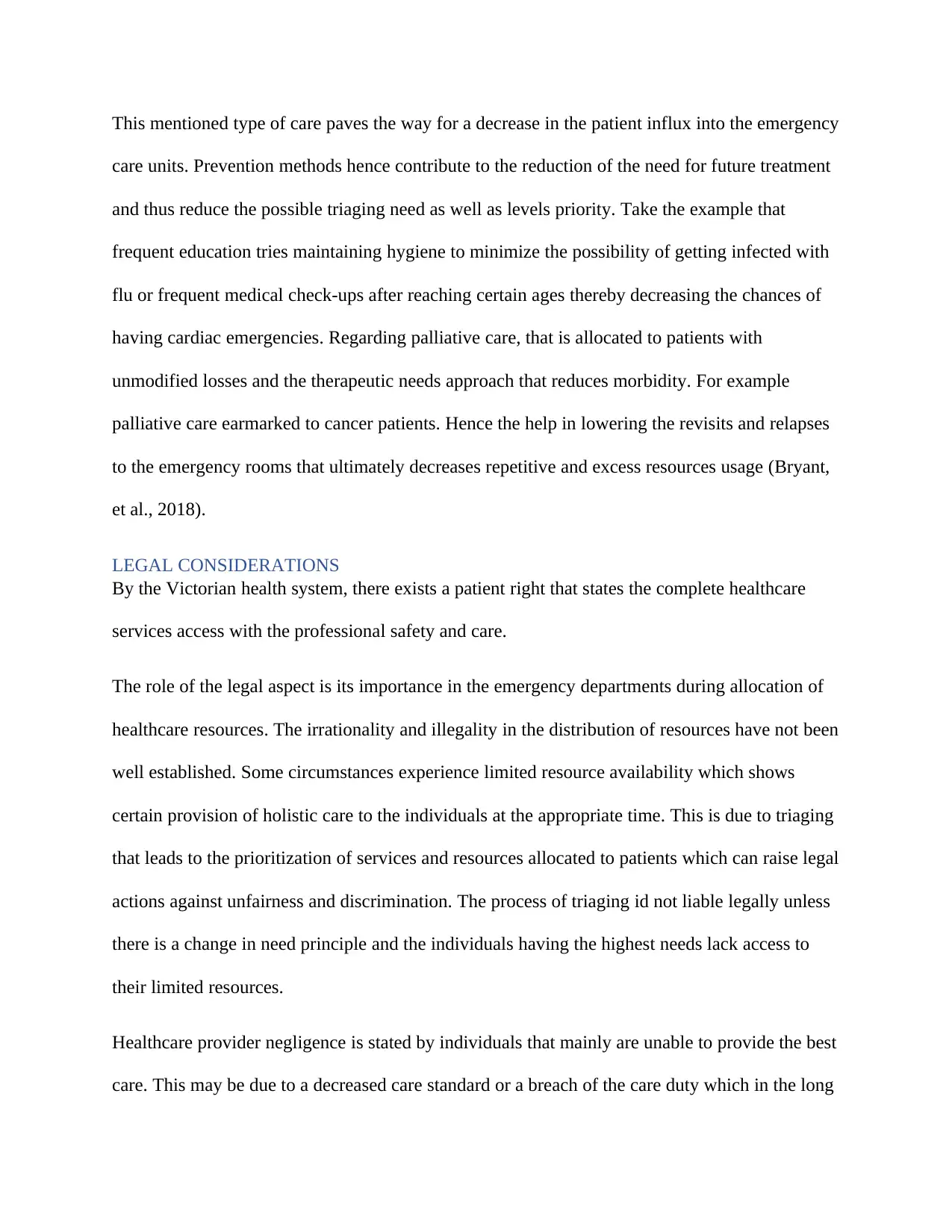
This mentioned type of care paves the way for a decrease in the patient influx into the emergency
care units. Prevention methods hence contribute to the reduction of the need for future treatment
and thus reduce the possible triaging need as well as levels priority. Take the example that
frequent education tries maintaining hygiene to minimize the possibility of getting infected with
flu or frequent medical check-ups after reaching certain ages thereby decreasing the chances of
having cardiac emergencies. Regarding palliative care, that is allocated to patients with
unmodified losses and the therapeutic needs approach that reduces morbidity. For example
palliative care earmarked to cancer patients. Hence the help in lowering the revisits and relapses
to the emergency rooms that ultimately decreases repetitive and excess resources usage (Bryant,
et al., 2018).
LEGAL CONSIDERATIONS
By the Victorian health system, there exists a patient right that states the complete healthcare
services access with the professional safety and care.
The role of the legal aspect is its importance in the emergency departments during allocation of
healthcare resources. The irrationality and illegality in the distribution of resources have not been
well established. Some circumstances experience limited resource availability which shows
certain provision of holistic care to the individuals at the appropriate time. This is due to triaging
that leads to the prioritization of services and resources allocated to patients which can raise legal
actions against unfairness and discrimination. The process of triaging id not liable legally unless
there is a change in need principle and the individuals having the highest needs lack access to
their limited resources.
Healthcare provider negligence is stated by individuals that mainly are unable to provide the best
care. This may be due to a decreased care standard or a breach of the care duty which in the long
care units. Prevention methods hence contribute to the reduction of the need for future treatment
and thus reduce the possible triaging need as well as levels priority. Take the example that
frequent education tries maintaining hygiene to minimize the possibility of getting infected with
flu or frequent medical check-ups after reaching certain ages thereby decreasing the chances of
having cardiac emergencies. Regarding palliative care, that is allocated to patients with
unmodified losses and the therapeutic needs approach that reduces morbidity. For example
palliative care earmarked to cancer patients. Hence the help in lowering the revisits and relapses
to the emergency rooms that ultimately decreases repetitive and excess resources usage (Bryant,
et al., 2018).
LEGAL CONSIDERATIONS
By the Victorian health system, there exists a patient right that states the complete healthcare
services access with the professional safety and care.
The role of the legal aspect is its importance in the emergency departments during allocation of
healthcare resources. The irrationality and illegality in the distribution of resources have not been
well established. Some circumstances experience limited resource availability which shows
certain provision of holistic care to the individuals at the appropriate time. This is due to triaging
that leads to the prioritization of services and resources allocated to patients which can raise legal
actions against unfairness and discrimination. The process of triaging id not liable legally unless
there is a change in need principle and the individuals having the highest needs lack access to
their limited resources.
Healthcare provider negligence is stated by individuals that mainly are unable to provide the best
care. This may be due to a decreased care standard or a breach of the care duty which in the long
⊘ This is a preview!⊘
Do you want full access?
Subscribe today to unlock all pages.

Trusted by 1+ million students worldwide
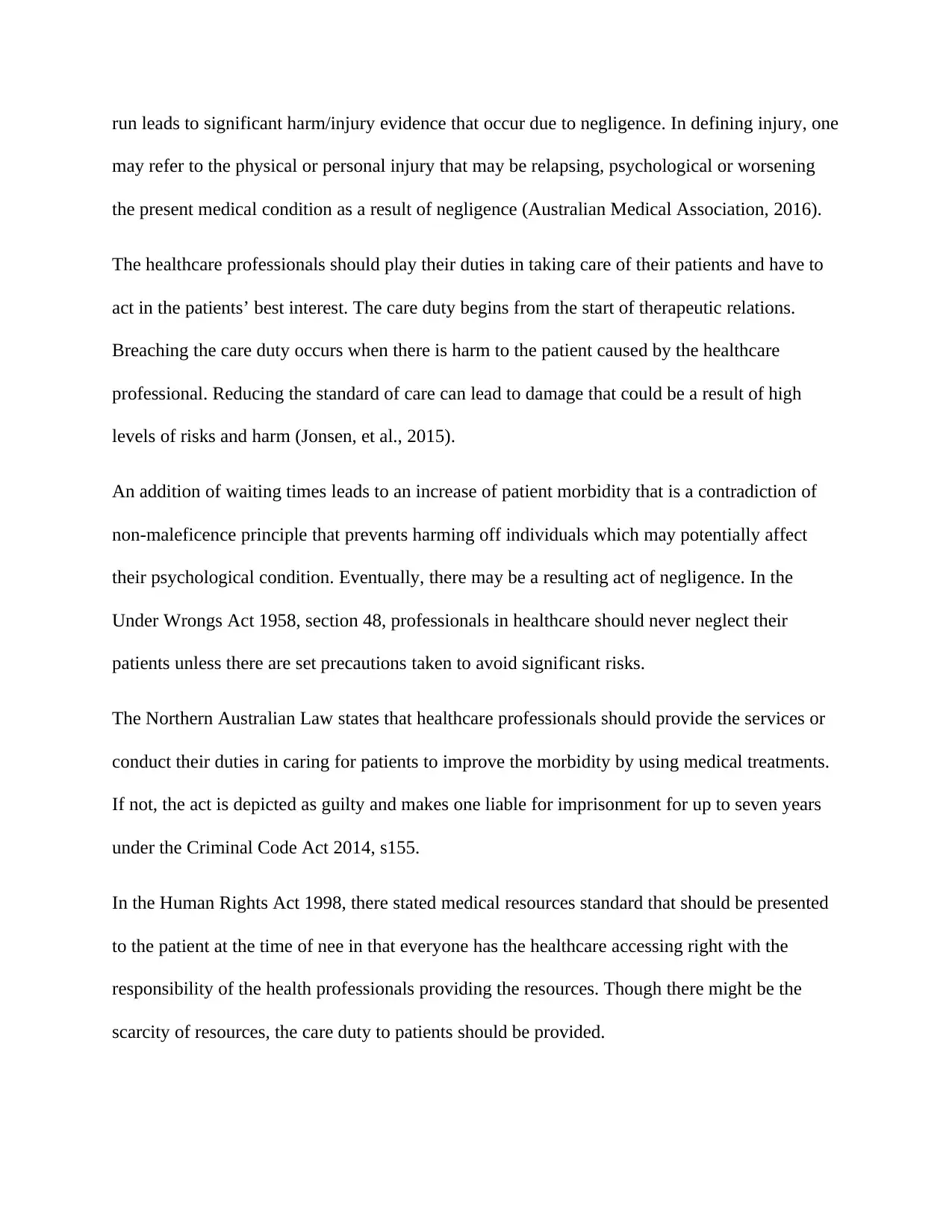
run leads to significant harm/injury evidence that occur due to negligence. In defining injury, one
may refer to the physical or personal injury that may be relapsing, psychological or worsening
the present medical condition as a result of negligence (Australian Medical Association, 2016).
The healthcare professionals should play their duties in taking care of their patients and have to
act in the patients’ best interest. The care duty begins from the start of therapeutic relations.
Breaching the care duty occurs when there is harm to the patient caused by the healthcare
professional. Reducing the standard of care can lead to damage that could be a result of high
levels of risks and harm (Jonsen, et al., 2015).
An addition of waiting times leads to an increase of patient morbidity that is a contradiction of
non-maleficence principle that prevents harming off individuals which may potentially affect
their psychological condition. Eventually, there may be a resulting act of negligence. In the
Under Wrongs Act 1958, section 48, professionals in healthcare should never neglect their
patients unless there are set precautions taken to avoid significant risks.
The Northern Australian Law states that healthcare professionals should provide the services or
conduct their duties in caring for patients to improve the morbidity by using medical treatments.
If not, the act is depicted as guilty and makes one liable for imprisonment for up to seven years
under the Criminal Code Act 2014, s155.
In the Human Rights Act 1998, there stated medical resources standard that should be presented
to the patient at the time of nee in that everyone has the healthcare accessing right with the
responsibility of the health professionals providing the resources. Though there might be the
scarcity of resources, the care duty to patients should be provided.
may refer to the physical or personal injury that may be relapsing, psychological or worsening
the present medical condition as a result of negligence (Australian Medical Association, 2016).
The healthcare professionals should play their duties in taking care of their patients and have to
act in the patients’ best interest. The care duty begins from the start of therapeutic relations.
Breaching the care duty occurs when there is harm to the patient caused by the healthcare
professional. Reducing the standard of care can lead to damage that could be a result of high
levels of risks and harm (Jonsen, et al., 2015).
An addition of waiting times leads to an increase of patient morbidity that is a contradiction of
non-maleficence principle that prevents harming off individuals which may potentially affect
their psychological condition. Eventually, there may be a resulting act of negligence. In the
Under Wrongs Act 1958, section 48, professionals in healthcare should never neglect their
patients unless there are set precautions taken to avoid significant risks.
The Northern Australian Law states that healthcare professionals should provide the services or
conduct their duties in caring for patients to improve the morbidity by using medical treatments.
If not, the act is depicted as guilty and makes one liable for imprisonment for up to seven years
under the Criminal Code Act 2014, s155.
In the Human Rights Act 1998, there stated medical resources standard that should be presented
to the patient at the time of nee in that everyone has the healthcare accessing right with the
responsibility of the health professionals providing the resources. Though there might be the
scarcity of resources, the care duty to patients should be provided.
Paraphrase This Document
Need a fresh take? Get an instant paraphrase of this document with our AI Paraphraser
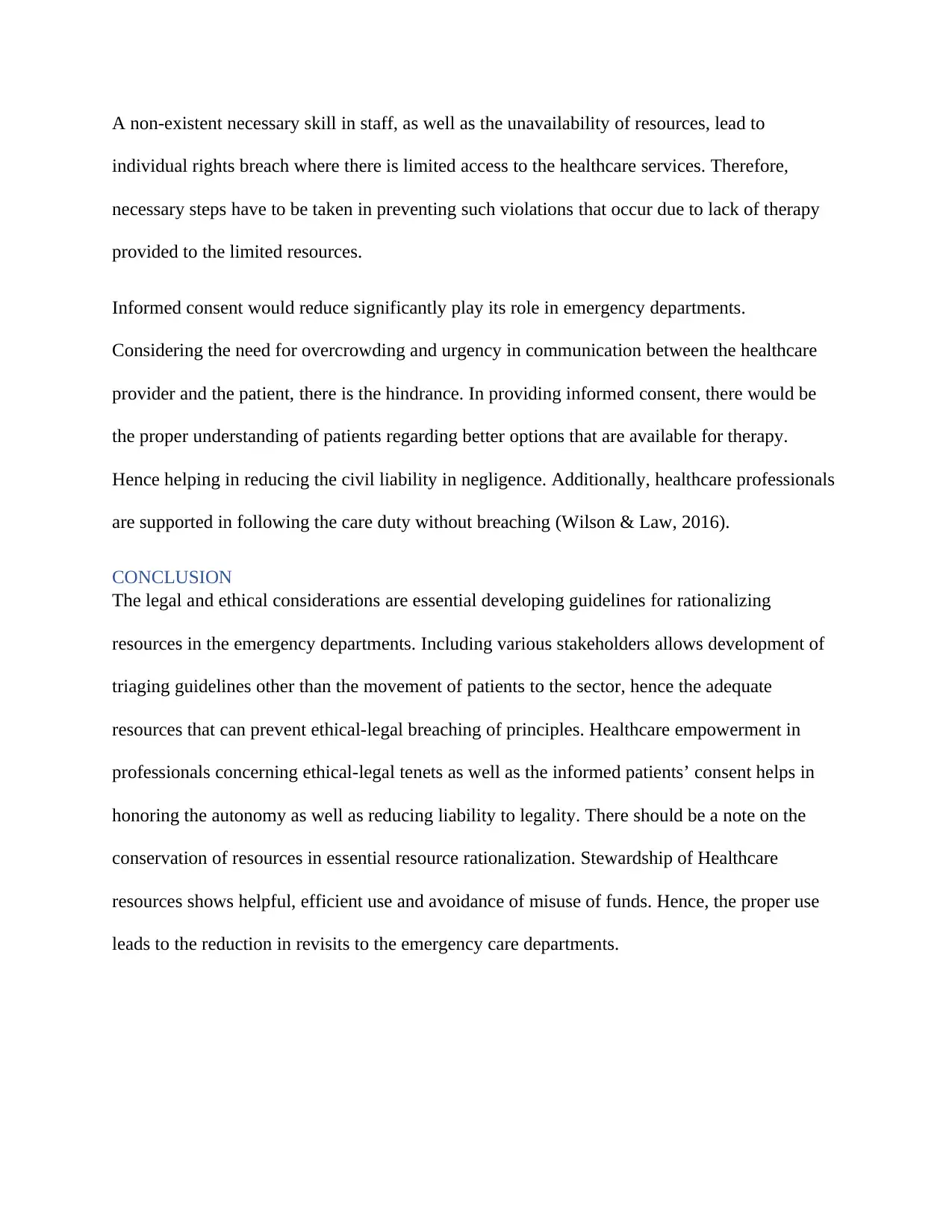
A non-existent necessary skill in staff, as well as the unavailability of resources, lead to
individual rights breach where there is limited access to the healthcare services. Therefore,
necessary steps have to be taken in preventing such violations that occur due to lack of therapy
provided to the limited resources.
Informed consent would reduce significantly play its role in emergency departments.
Considering the need for overcrowding and urgency in communication between the healthcare
provider and the patient, there is the hindrance. In providing informed consent, there would be
the proper understanding of patients regarding better options that are available for therapy.
Hence helping in reducing the civil liability in negligence. Additionally, healthcare professionals
are supported in following the care duty without breaching (Wilson & Law, 2016).
CONCLUSION
The legal and ethical considerations are essential developing guidelines for rationalizing
resources in the emergency departments. Including various stakeholders allows development of
triaging guidelines other than the movement of patients to the sector, hence the adequate
resources that can prevent ethical-legal breaching of principles. Healthcare empowerment in
professionals concerning ethical-legal tenets as well as the informed patients’ consent helps in
honoring the autonomy as well as reducing liability to legality. There should be a note on the
conservation of resources in essential resource rationalization. Stewardship of Healthcare
resources shows helpful, efficient use and avoidance of misuse of funds. Hence, the proper use
leads to the reduction in revisits to the emergency care departments.
individual rights breach where there is limited access to the healthcare services. Therefore,
necessary steps have to be taken in preventing such violations that occur due to lack of therapy
provided to the limited resources.
Informed consent would reduce significantly play its role in emergency departments.
Considering the need for overcrowding and urgency in communication between the healthcare
provider and the patient, there is the hindrance. In providing informed consent, there would be
the proper understanding of patients regarding better options that are available for therapy.
Hence helping in reducing the civil liability in negligence. Additionally, healthcare professionals
are supported in following the care duty without breaching (Wilson & Law, 2016).
CONCLUSION
The legal and ethical considerations are essential developing guidelines for rationalizing
resources in the emergency departments. Including various stakeholders allows development of
triaging guidelines other than the movement of patients to the sector, hence the adequate
resources that can prevent ethical-legal breaching of principles. Healthcare empowerment in
professionals concerning ethical-legal tenets as well as the informed patients’ consent helps in
honoring the autonomy as well as reducing liability to legality. There should be a note on the
conservation of resources in essential resource rationalization. Stewardship of Healthcare
resources shows helpful, efficient use and avoidance of misuse of funds. Hence, the proper use
leads to the reduction in revisits to the emergency care departments.
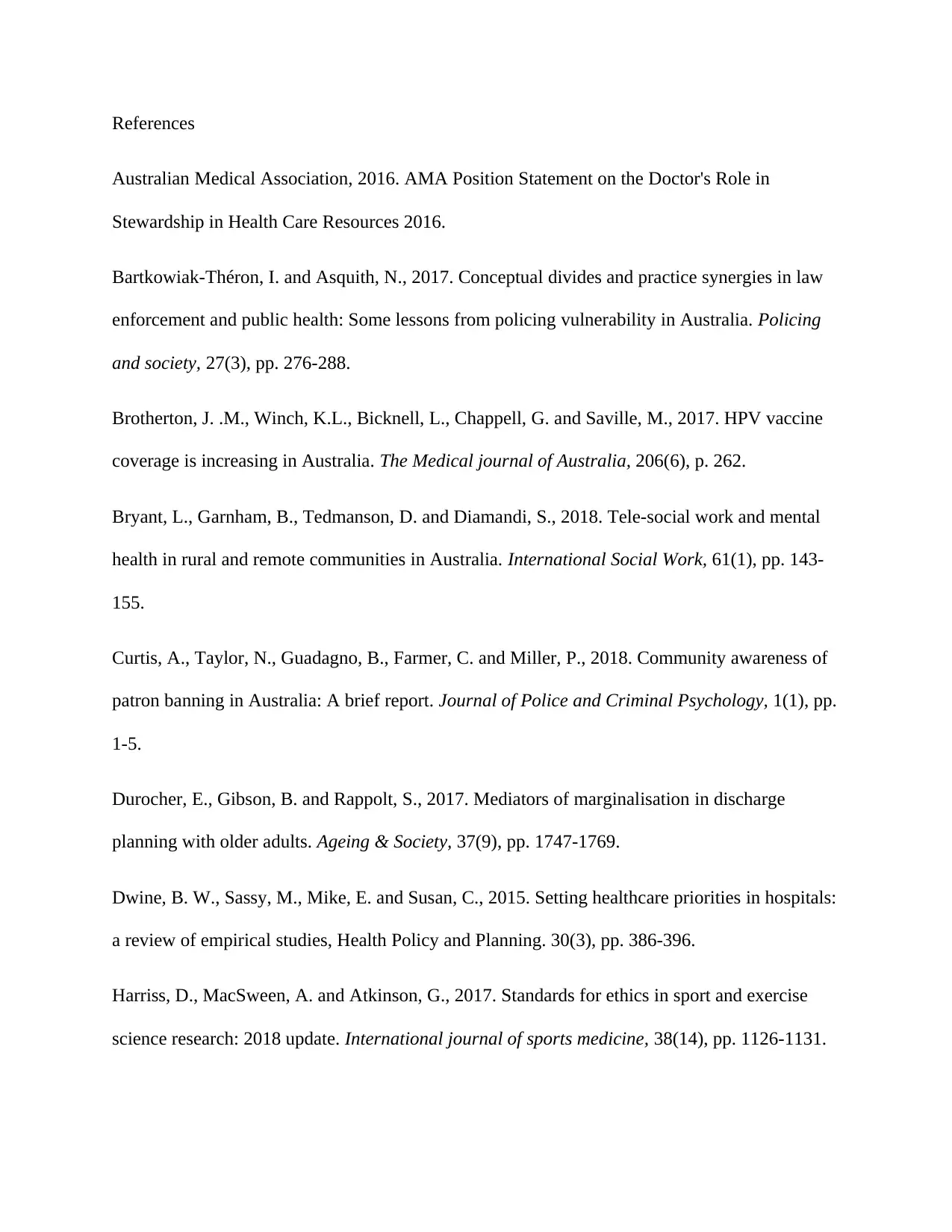
References
Australian Medical Association, 2016. AMA Position Statement on the Doctor's Role in
Stewardship in Health Care Resources 2016.
Bartkowiak-Théron, I. and Asquith, N., 2017. Conceptual divides and practice synergies in law
enforcement and public health: Some lessons from policing vulnerability in Australia. Policing
and society, 27(3), pp. 276-288.
Brotherton, J. .M., Winch, K.L., Bicknell, L., Chappell, G. and Saville, M., 2017. HPV vaccine
coverage is increasing in Australia. The Medical journal of Australia, 206(6), p. 262.
Bryant, L., Garnham, B., Tedmanson, D. and Diamandi, S., 2018. Tele-social work and mental
health in rural and remote communities in Australia. International Social Work, 61(1), pp. 143-
155.
Curtis, A., Taylor, N., Guadagno, B., Farmer, C. and Miller, P., 2018. Community awareness of
patron banning in Australia: A brief report. Journal of Police and Criminal Psychology, 1(1), pp.
1-5.
Durocher, E., Gibson, B. and Rappolt, S., 2017. Mediators of marginalisation in discharge
planning with older adults. Ageing & Society, 37(9), pp. 1747-1769.
Dwine, B. W., Sassy, M., Mike, E. and Susan, C., 2015. Setting healthcare priorities in hospitals:
a review of empirical studies, Health Policy and Planning. 30(3), pp. 386-396.
Harriss, D., MacSween, A. and Atkinson, G., 2017. Standards for ethics in sport and exercise
science research: 2018 update. International journal of sports medicine, 38(14), pp. 1126-1131.
Australian Medical Association, 2016. AMA Position Statement on the Doctor's Role in
Stewardship in Health Care Resources 2016.
Bartkowiak-Théron, I. and Asquith, N., 2017. Conceptual divides and practice synergies in law
enforcement and public health: Some lessons from policing vulnerability in Australia. Policing
and society, 27(3), pp. 276-288.
Brotherton, J. .M., Winch, K.L., Bicknell, L., Chappell, G. and Saville, M., 2017. HPV vaccine
coverage is increasing in Australia. The Medical journal of Australia, 206(6), p. 262.
Bryant, L., Garnham, B., Tedmanson, D. and Diamandi, S., 2018. Tele-social work and mental
health in rural and remote communities in Australia. International Social Work, 61(1), pp. 143-
155.
Curtis, A., Taylor, N., Guadagno, B., Farmer, C. and Miller, P., 2018. Community awareness of
patron banning in Australia: A brief report. Journal of Police and Criminal Psychology, 1(1), pp.
1-5.
Durocher, E., Gibson, B. and Rappolt, S., 2017. Mediators of marginalisation in discharge
planning with older adults. Ageing & Society, 37(9), pp. 1747-1769.
Dwine, B. W., Sassy, M., Mike, E. and Susan, C., 2015. Setting healthcare priorities in hospitals:
a review of empirical studies, Health Policy and Planning. 30(3), pp. 386-396.
Harriss, D., MacSween, A. and Atkinson, G., 2017. Standards for ethics in sport and exercise
science research: 2018 update. International journal of sports medicine, 38(14), pp. 1126-1131.
⊘ This is a preview!⊘
Do you want full access?
Subscribe today to unlock all pages.

Trusted by 1+ million students worldwide
1 out of 13
Related Documents
Your All-in-One AI-Powered Toolkit for Academic Success.
+13062052269
info@desklib.com
Available 24*7 on WhatsApp / Email
![[object Object]](/_next/static/media/star-bottom.7253800d.svg)
Unlock your academic potential
Copyright © 2020–2025 A2Z Services. All Rights Reserved. Developed and managed by ZUCOL.





